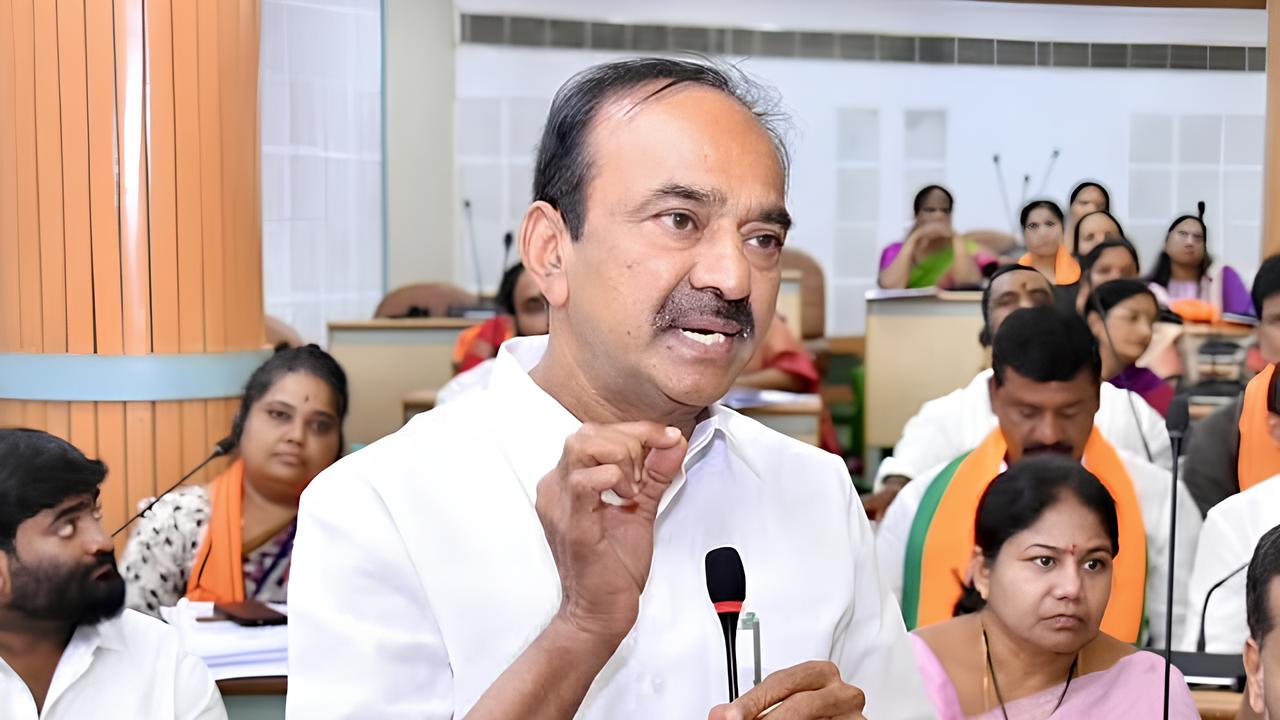Rajender, who served as the Finance Minister in the first KCR cabinet, appeared before the Justice PC Ghose Commission on Friday. When asked about several financial decisions taken during the BRS government, he maintained that all decisions made during his tenure followed due procedure.
Published Jun 06, 2025 | 4:27 PM ⚊ Updated Jun 06, 2025 | 4:27 PM

Rajender was the 113th witness to appear before the Justice PC Ghose commission.
Synopsis: BJP MP Eatala Rajender has called for the public release of the PC Ghose Commission report on alleged irregularities in the Kaleshwaram Lift Irrigation Scheme and demanded strict action against those found responsible. He appeared before the judicial panel on 6 June, testifying about his role as Telangana’s Finance Minister during the project’s early phase and reiterated his demand for the commission’s findings to be made public.
Telangana Bharatiya Janata Party (BJP) MP Eatala Rajender on Friday, 6 June demanded that the report of the judicial inquiry into alleged irregularities in the execution of the Kaleshwaram Lift Irrigation Scheme (KLIS) be made public upon its completion.
The Malkajgiri MP also called for strict action against those found responsible for lapses in the multi-crore irrigation project.
Rajender, who served as Telangana’s first Finance Minister from 2014 to 2018 and later as Health Minister from 2019 to 2021, resigned from the Bharat Rashtra Samiti (BRS, formerly Telangana Rashtra Samithi) after being sacked over alleged land encroachment. He subsequently joined the BJP.
He deposed before the Justice PC Ghose Commission on Friday for approximately 40 minutes at BRK Bhavan in Hyderabad.
The one-man commission was constituted by the ruling Congress in March 2024 to investigate the financial and technical irregularities in the implementation of the KLIS during the previous BRS government.
“Even if a gun is pointed at my temple, I will speak only the truth. I have always spoken the truth and will continue to do so,” Rajender told reporters afterwards and reiterated his call for transparency in the inquiry.
“The government must release the commission’s report and clearly identify those who were guilty. The people have a right to know who the real culprits are.”
The Kaleshwaram Lift Irrigation Scheme, a flagship initiative of the previous BRS administration, was conceived to meet irrigation and drinking water needs across Telangana.
However, allegations of inflated project costs, structural failures – such as damage to the Medigadda barrage – and financial irregularities have led to a comprehensive judicial probe that remains ongoing.
Rajender’s appearance before the commission attracted considerable public attention.
A large number of supporters accompanied him from his residence in Shamirpet to BRK Bhavan. In open court, he took an oath administered by the commission chairman, affirming his commitment to truth.
He was the 113th witness to appear before the panel. The commission’s questioning primarily focused on his role as Finance Minister during the early phase of the project.
The Justice Ghose Commission has so far recorded testimonies from several senior officials, including former and serving Engineers-in-Chief, Chief Engineers, and IAS officers.
The inquiry continues to examine the financial, administrative, and technical aspects of the project.
Rejecting any attempt to implicate him in the controversy, Rajender stated, “Some may try to pin the blame on me, but it won’t affect me. My life has been one of commitment, and I will always speak the truth, regardless of who questions me.”
During his deposition, he was also asked about several financial decisions taken during the BRS government, including fund allocations and cabinet resolutions.
He maintained that all decisions made during his tenure followed due procedure.
“The CWC report was placed before the Finance Department, and all decisions were made with proper scrutiny,” he said.
“In my 25 years of political life, across different parties, I have always adhered to values. Telangana was formed to meet the aspirations of the people for water, funds, and jobs. We tried our best to address those needs.”
Rajender also addressed the cost escalation – from the original estimate of ₹63,000 crore to ₹82,000 crore – and attributed part of the increase to the relocation of the project site from Thummidihatti to Medigadda, following objections from the Maharashtra government.
“The decision to relocate the project and its construction was made by the cabinet, based on reports from the cabinet sub-committee and technical committees,” he said.
He argued that irrigation projects are fundamentally technical in nature and should not be politicised.
“Political leaders are not expected to understand the technical details,” he added.
Responding to queries on the Detailed Project Report (DPR), the construction of the Medigadda, Annaram, and Sundilla barrages, and the functioning of the Kaleshwaram Corporation, Rajender clarified: “The commission asked if I had anything to do with the project’s design or construction. I said I had none. I had no authority over the Kaleshwaram Corporation either.”
He stressed that the corporation functioned independently, and technical accountability lay with engineers.
“K Chandrashekar Rao himself had said he was the one who visualised and conceptualised the project. It was his brainchild, and he was the boss at the time,” Rajender said.
He added that the project was implemented by a cabinet sub-committee led by then Minister T Harish Rao, based on recommendations from the Central Water Commission (CWC) and other technical bodies.
(Edited by Dese Gowda)
